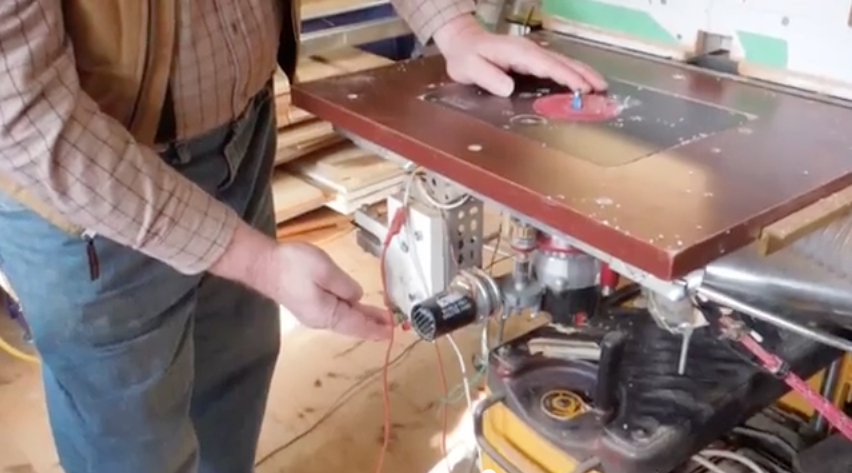DIY Motorized Router Table Lift Mechanism and Two Other Innovative Router Tables

A router is a versatile and useful tool, although a pretty crazy one too. It’s a compact, high-powered motor that holds a narrow cylindrical blade (“bit”), spinning at ultra-high speeds with massive force. Routers are used for ornamental design work (look at the recessed borders cut into your cabinet doors — that’s routed) and cutting material. A variety of bit shapes allow for different contours of cuts — straight, angled, curved, curved with a protruding angle, etc.
Most commonly, routers are handheld with the bit extending downwards into the material being carved out. They’re guided over a piece of material to make freehand cuts, or with a guide to help ensure straight lines. The gyroscopic effect makes them a bit funky to control, and the power of the motor can send some serious fragments flying — including the router or user if things get hung up.
Sometimes, however, the router will be flipped upside-down and mounted underneath a table, with the bit extending upwards — combined like this, it’s called a router table. Keeping the router stable and moving just the material allows for more precise control of the cuts, especially if combined with a fence to guide straight movement.
One downside of the router table setup is that the router controls are not as accessible once placed in a cabinet space under the work surface — this is especially true for bit depth adjustments, a very crucial part of routing. Some manufacturers have devised a through-the-table screw adjustment that lets you move things up and down, but this can still be hard to do if you’re in the middle of a project or cut.
This video shows a very innovative approach to this situation–a mechanized router lift built by workshop mastermind Bill Price. Using a car window motor and a few very innovative ideas, he’s got a system that allows for easy access adjustments on the fly. And he’s even incorporated a system that allows for automatic height measurement and adjustment based on the item you’re routing. Awesome.
Here are two other router table systems that incorporate novel solutions — the first, a highly configurable router table that uses simple folding components and a bungee strap for the elastic resistance needed. The video is mesmerizing in its lack of vocalized description, instead relying on a very effective demonstration of the table’s various setups, while set in what appears to be an abandoned industrial workshop somewhere in Russia.
The second is Matthias Wendel’s wooden-geared router table mechanism. Matthias, of the site woodgears.ca, builds some mind blowing projects entirely from wood (I’ll post about his homemade all-wood bandsaw soon). This lift, like all his projects, is super accurate and extremely useful.
The thought of building one of these for yourself can be a bit daunting; fortunately there are plenty of commercial options available (although usually without the innovations seen here — I suspect they’ll get added soon though). Check out this Bosch router table for something that is compact but affordable, and includes a wide range of options.
These two great books will also get you up to speed on routing and router tables: “Taunton’s Complete Guide to Routers” and “Bill Hylton’s Ultimate Guide to the Router Table”


